Lynar Tablatures
The Lynar tablatures are a collection of manuscripts that are currently held in the Staatsbibliothek, Berlin. It has been interpreted as one of the most important sources for the works of the North-German pupils of Jan Pieterszoon Sweelinck.
With a few exceptions, the Lynar Tablatures exclusively transmit keyboard music, mostly for organ. The exceptions are one manuscript which appears to contain an Intabulation of a cantata (see B 10) and another which appears to be transcribed from a psalm part book (C).
The Lynar Tablatures are highly varied in their size and the pieces they contain. The individual manuscripts range in size from containing a fragment of a single piece or two präludia which fit on a single two-page opening to containing as many as 81 pieces or settings of all 150 psalms. The pieces contained in these manuscripts (some attributed to composers, others anonymous) have been connected to many different regions of Europe including the German-speaking Lands, the Netherlands, Poland, Italy, France and England. Likewise, they include a wide variety of genres of pieces including toccatas, Präludia, dance movements, canzonas and other fugal polyphonic works, variation cycles on chorales psalms and secular songs, and chorale settings–including the more developed German Chorale Fantasia.
The composers who are represented the most within the Lynar tablatures are Jan Pieterszoon Sweelinck, Christian Erbach, and Heinrich Scheidemann. Over time, many of the other anonymous compositions have been linked to composers based on concordances and stylistic analysis.
The Lynar Tablatures themselves (as well as the pieces within) have been covered in-depth by many musicologists, including Lydia Schierning in her extensive book on manuscripts of german early keyboard music, and Pieter Dirksen in various books and publications.
Thankfully, now all of the Lynar Tablatures (except C 1) are available online.
History[1]
The first Lynar tablatures that were known to musicologists were the A 1 and A 2 manuscripts. These two manuscripts had copies made of them in the middle of the 19th century. Later in the 19th century both manuscripts went missing (In the 1894 edition of keyboard works of Sweelinck, Max Seiffert could only rely on the 1841 copy). However, the "A" manuscripts were fortunately found in 1920, and around this time the 11 manuscripts in tablature notation were discovered by Rochus Friedrich zu Lynar. All 13 manuscripts were collected and stored in the Spreewald museum in Lübbenau-Lehde. In 1933[2] Max Seiffert inspected the manuscripts and assigned the shelfmarks starting with A (referring to staff notation) and B (tablature notation). The description penciled on the front of each manuscript is written by Seiffert.
The Lynar B collection of tablatures was discovered more recently. They were found during the reorganization of the castle papers for removal to a newly founded city museum in the 1920s. According to Hans Joachim Moser, the first musicologist to see them, they consisted of nothing but a large, disordered pile of paper–partly gathered in bundles, partly consisting of loose sheets and notated in organ tablature.[3]
In 1956, the manuscripts were moved to the Staadtsbibliothek, Berlin, retaining their previous shelfmarks.
Description
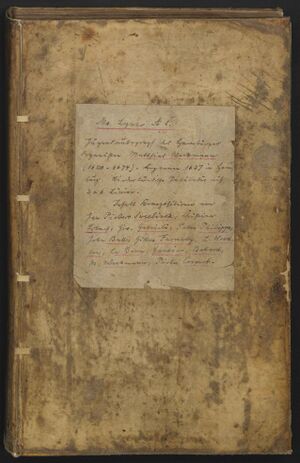
Each Lynar Tablature has a sheet pasted on the front with a description penciled in by Max Seiffert (the text is reproduced below).
According to the Berlin Staatsbibliothek website, the shelfmark for the manuscripts is stylized Ms. Lynar A 1, Ms. Lynar B 2, etc.. One manuscript has the shelfmark Ms. Lynar C 1, but it has been called "Lynar C" or "Lynar B 11" in some sources.
The "A" tablatures are in various types of staff notation, and the "B" (and "C") tablatures are in New German Tablature Notation.
Analysis
Lynar A Tablatures
...the Lynar A manuscripts must be particularly close to Sweelinck's autographs, if not actually copied directly from them–which seems not only to hold for the large collection of Sweelinck pieces themselves (in Lynar A 1) but for much of the remaining content as well, including the large virginalist section in LyA2.[4]
Lynar B Tablatures
Pieter Dirksen[5]
The Lynar B tablatures as a whole must now be seen as a closely connected series of sources which probably actually originated within the North German Sweelinck school, going back directly to one of the North German Sweelinck pupils.[6]
The Lynar B tablatures have proven valuable as a source of works from the North-German Sweelinck school as well as from Sweelinck himself, as thirteen works (including 10 not known from any other source) by him are found within.
Dirksen interprets the 11 "B" tablatures as forming a unified whole because (among other reasons) it can be identified that some of the unknown copyists wrote more than one manuscript each.
As for the originating location of the manuscripts, the area of Gdańsk (german: Danzig) was theorized based on the inclusion of pieces by Paul Siefert and Andreas Neunhaber. Similarly based on circumstantial evidence, the manuscripts can be dated to around the 1620s (even though some pieces within can be dated to later). One date found within the manuscript, 1628, also suggests this.
Dirksen notes that the works by Sweelinck must have been transcribed from Anglo-Dutch staff notation to New German Tablature Notation.
References
Beckmann, Klaus, Die Norddeutsche Schule. Teil II: Blütezeit und Verfall. Mainz: Schott, 2009. ("Beckmann (2009)")
Dirksen, Pieter. The Keyboard Music of Jan Pieterszoon Sweelinck: Its Style, Significance and Influence. Muziekhistorische Monografieen, vol. 15. Utrecht: Koninklijke Vereniging voor Nederlandse Muziekgeschiedenis, 1997. ("DirksenSweelinck")
Dirksen, Pieter. Heinrich Scheidemann's Keyboard Music: Transmission, Style and Chronology. Aldershot: Ashgate, 2007. ("DirksenScheidemann")
Schierning, Lydia. Die Überlieferung der deutschen Orgel- und Klaviermusik aus der esten Hälfte des 17. Jahrhunderts: Eine quellenkundliche Studie. Kassel: Bärenreiter, 1961.
- ↑ Schnieders, Hans, "Fingersätze für Tasteninstrumente aus dem Umfeld Sweelincks und seiner Schüler". [1], accessed 15 September, 2023. 2.15 Lynar A1
- ↑ Seiffert, Max (editor), Sweelinck: Werken voor Orgel en Clavecimbel. Amsterdam: G. Alsbach & Co., 1942. xlvi
- ↑ Dirksen, Pieter (editor). Psalm Variations from Lynar B 7. Exempla Musica Neerlandica XVIII. Utrecht: Koninklijke Vereniging voor Nederlandse Muziekgeschiedenis, 1996. V
- ↑ DirksenScheidemann, 144-145.
- ↑ DirksenScheidemann, 9-10.
- ↑ Dirksen, Pieter (editor). Psalm Variations from Lynar B 7. Exempla Musica Neerlandica XVIII. Utrecht: Koninklijke Vereniging voor Nederlandse Muziekgeschiedenis, 1996. VIII
Contents
Lynar A 1
Seiffert: Ms. Lynar A 1 | Jugendautograph des Hamburger | Organisten Matthias Weckmann | (1620-1674), begonnen 1637 in Ham- | burg. Niederländische Tabulatur auf | 2 x 6 Linien. | Inhalt Kompositionen von | Jan Pieters Sweelinck, Christian | Erbach, Gio. Gabrieli, Peter Philipps, | John Bull, Gilles Farnaby, L. Wood- | sen, La Barre, Gautier, Ballard, | M. Weckmann, Pieter Cornet.
Ms. Lynar A 1: Young autograph by the Hamburg organist Matthias Weckmann (1620-1674), begun in 1637 in Hamburg. Dutch tablature on 2x6 lines. ...
D-B Ms. Lynar A 1 Online facsimile: digital.staatsbibliothek-berlin.de accessed 15 December, 2023.
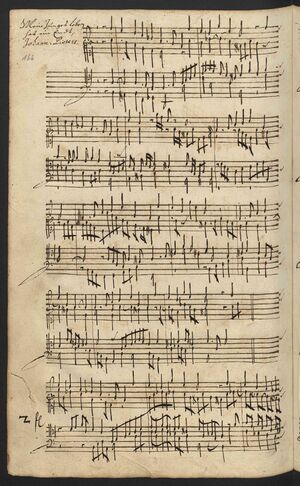
Ms. Lynar A 1 is a manuscript in Dutch 6-line staff notation. It contains 81 keyboard pieces. It is one of the first manuscripts to be known to early musicologists and has been called "the primary source for the keyboard music of Jan Pieterszoon Sweelinck"[1].
Despite going missing in the late 19th century, this manuscript has since been rediscovered.
Actually, the scribe of the manuscript is not Matthias Weckmann (like Max Seiffert said)[2][3].
Description
Max Seiffert said that the scribe of the manuscript was Matthias Weckmann while he was a student of Jakob Praetorius.[4] One possible reason for this is that the manuscript was located in the Hamburg Universitätsbibliothek when it was inspected by him.[5]
However, when comparing this manuscript with the Visby Tablature, which was written in similar circumstances (by Berendt Petri while studying with Jakob Praetorius), the difference in repertoire can be seen. Actually, based on the use of the organ in North-Germany, Jakob Praetorius and his students would only have use for verses and variations on chorales, hymns, magnificats, motet intabulations and short preludiums.[6]. It seems unlikely that J. Praetorius would have changed his teaching (including choice of pieces) and at the same time it would not be usable for his student from Hamburg.[7] For this reason, a North-German origin of this manuscript (under the teaching of Jakob Praetorius) is doubtful.[8]
On the question of proximity to Autographs by Sweelinck, Pieter Dirksen says that the manuscript must have had an origin close to Sweelinck and his school, not only based on the selection of pieces included but also their high copying quality.
The Sweelinck pieces are copied with hardly any mistakes at all, and anyone who has worked with manuscript sources knows how rare such a state of affairs is.[9]
In addition, The scribe apparently had access to an exclusive strain of the Sweelinck transmission,[10] as many high-quality pieces (including Mein junges Leben hat ein End) are included which would surely be copied by other scribes if they had access to them. Also, the staff notation layout (two staves with six lines each) and other aspects of the notation (including the musicality of the two hands over the two staves) suggest a direct connection to Sweelinck autographs.[11]
However, Klaus Beckmann noted that it seems odd that someone so close to Sweelinck (or even a student of him) would badly misspell his name, as happens for some of the pieces. This was part of his argument that some pieces–in which the written composer name is Johann. Pieters.–were composed by the Sweelinck student Johann Praetorius.[12]
Contents
| Pages | Title | Incipit | Notes | Ref. |
|---|---|---|---|---|
Analysis
[14]One piece, Fantasia Ut sol fa mi by Joan Pieters (=Jan Pieterszoon Sweelinck) is also found in a manuscript from the collection of Messaus (Ms. 18 Bd. 1) which was later owned by William Kitchiner and Richard Clark and is now lost. Here, it is titled God save the King, dated 1616, and attributed to John Bull. This piece is included in Musica Britannica volume 14, the keyboard works by John Bull, with this other title (as well as in Seiffert's Sweelinck edition in 1942 titled Fantasia...). On the question of authorship, even though the editor of the Musica Brittanica edition, Thurston Dart, said that Messaus's attributions could generally not be trusted as much as those by other scribes, the authorship of this piece by Bull is still possible. The appearance of this piece in two manuscripts by two different composers can be explained by the following possibility: it seems likely that John Bull gave his friend Sweelinck a copy of this piece (Bull was already found in Holland in 1613), and this copy was consulted by the copyist of Lynar A 1 (who wrote Sweelinck's name).
References
Schierning, 66-81
DirksenSweelinck, 20-22, 656-658
- ↑ Dirksen, Pieter (editor). Psalm variations from Lynar B 7. Utrecht: Koninklijke Vereniging voor Nederlandse Muziekgeschiedenis, 1996. Page V.
- ↑ Schierning, 78
- ↑ DirksenSweelinck, 21
- ↑ Schierning, 78
- ↑ Schierning, 78. Dieses Manuskript war bis zu seiner Vernichtung im letzten Krieg im Besitz der Hamburger Universitätsbibliothek...
- ↑ Schierning, 79
- ↑ Schierning, 79
- ↑ Schierning, 79. Diese Fragen werden kaum zu bejahen sein, somit ist eine norddeutsche Herkunft der Handschrift stark zu bezweifeln
- ↑ DirksenSweelinck 21.
- ↑ DirksenSweelinck 22.
- ↑ DirksenSweelinck 22.
- ↑ Beckmann (2009) p.166-172.
- ↑ DirksenSweelinck 656-658.
- ↑ Margarete Reimann. "Die Autoren der Fuge Nr. 23 in Lüneburg KN 208^1 und der Fantasia Ut sol fa mi in Lübbenau, Ms. Lynar A^1". Die Musikforschung, 16. Jahrg., H. 2 (APRIL/JUNI 1963), pp. 166-167. JSTOR
Lynar A 2
Seiffert: Italienisch-niederländische Tabulatur eines | süddeutschen Schreibers um 1610; 2 Systeme | 6 + 7 und 6 + 6 Linien. | Enthält Kompositionen von | Christian Erbach und der Engländer Will. | Byrd, Dr. Bull, Orlando Gibbons, | sowie einige von Gio. Gabrieli und Tarq. | Merula.
Italian-Dutch tablature from south-German scribes from 1610; 2 systems, 6+7 and 6+6 lines. ...
D-B Ms. Lynar A 2 Online facsimile: digital.staatsbibliothek-berlin.de accessed 15 December, 2023.
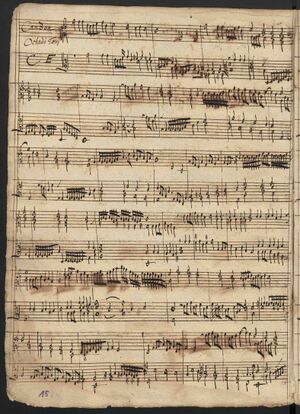
Ms. Lynar A 2 contains 42 Tasteninstrument pieces written in staff notation by Christian Erbach, Giovanni Gabrieli, Tarquinio Merula, William Byrd, John Bull, and Orlando Gibbons. Unlike Lynar A 1, this manuscript doesn't contain any works by Sweelinck.[1]
Description
The manuscript is written by multiple hands in "Italian-Dutch" staff notation. Some pieces are written on two 6-line staves, and some are written on one 6- and one 7-line staff. Each page is 35x24.5cm in size.
In the early 20th century, the first and last pages of the manuscript (probably not written on) were concealed by binding paper for preservation purposes.
Contents
| p. | Title | Incipit | Notes | Ref. |
|---|---|---|---|---|
| 2-4 | Toccata. 2. toni / Christ: Erbach |
|||
| 5 | Toccata. 3 tij / Toni |
|||
| 6 | Toccata. 4. tij / toni / Christian Erbach |
|||
| 7-8 | Fuga j.mj / toni / Christian Erbach |
|||
| 8-9 | fantasia / 2. dj / Tonij |
|||
| 9 | Ricercar. 3. tij. / toni / Christian Erbach |
|||
| 10 | Canzon 4stij Toni Chr. Er. | |||
| 11-12 | Ricercar / coall / Quinti toni / C. E. |
|||
| 12-13 | Canzon / sexti Toni / C. E. |
|||
| 13-14 | Ricercar / 7.mi. Toni / C. E. |
|||
| 15-16 | Canzon / Octavi Toni / C. E |
|||
| 16-18 | Ricercar.g. / Tonj / Johan. Gabriell |
|||
| 19-20 | Canzon | |||
| 21-23 | Tacato / Secundi Tonj / Dell / Segnor Torquino / merula |
|||
| 23-24 | Canzon | |||
| 25-26 | Un Cromatico / ouero Capricio / dell Signor / Torquino merula / primo Tuono per / Le semituoni |
|||
| 27-28 | Intonatione / Cromatica / dell 3 / Tono |
|||
| 29-30 | Intonaglio Cromatica / dell / Quarto Tono |
|||
| 29-30 | Praeludium / primj Tonj |
|||
| 31-32 | Intonatio / Crommatica / dell / Nonj Tonj |
|||
| 33-34 | Canzon | |||
| 35-36 | Canzon | |||
| 37-38 | Pavan / sz: ae: mpetze / William Bÿrde / Angloss |
|||
| 39-40 | Galiardo / William Bÿrde |
|||
| 41-42 | Galliardo / Orlando Gibbons |
|||
| 43-44 | Pavana. / The Earle / of Salisburÿ / William birde |
|||
| 43-44 | Preludium / Doctor Bull |
|||
| 43-44 | Galliardo | |||
| 43-44 | Galiardo Secundo / Miss Matye Brosonlo / William Birde |
|||
| 45-46 | Preludium / Orlando Gibbons |
|||
| 47-48 | Galliardo / Orlando Gibbons |
|||
| 49-50 | Galliardo / Orlado Gibbons |
End: Finis Coronat / O Puc |
||
| 51-52 | Galliardo / orlando gibbons |
|||
| 53-58 | [no title] | 13 variations | ||
| 58 | [no title] | |||
| 59-62 | A. Voluntarge / M. Bird |
|||
| 63-66 | Tantasia / M. Bird |
References
Schierning, 81-84.
- ↑ DirksenSweelinck 21.
Lynar B 1
Seiffert: Ms. Lynar B 1 | Deutsche Orgeltabulatur vom 1. Drittel | des 17. Jhdt. | Enthält Kompositionen von | J. P. Sweelinck, Paul Siefert, | Andr. Düben, Jak.Prätorius, Peter | Hasse, Gottfr. Scheidt, Samuel Scheidt | W. Karges, D. H. und M. D.
Ms. Lynar B 1; German tablature from the first 3rd of the 17th century. Contains compositions frome Jan Pieterszoon Sweelinck, Paul Siefert, Andreas Düben, Jacob Praetorius, Peter Hasse, Gottfried Scheidt, Samuel Scheidt, Wilhelm Karges, D. H. and M. D.
D-B Ms. Lynar B 1 Online facsimile: digital.staatsbibliothek-berlin.de accessed 3 November, 2023.
Ms. Lynar B 1 contains 71 pages. Among other things, it contains a compilation of settings of Allein Gott in der Höh sey Ehr by different composers.
| No. | Title | notes |
|---|---|---|
| 1 | Fantasia Auff die manier von ein Echo. M. J. P. S. | Jan Pieterszoon Sweelinck |
| 2 | Puer natusin Bethlehem a Paulus Sivert | Paul Siefert |
| 3 | Nun komm der Heÿden Heÿlandt | Paul Siefert? |
| 4 | Nun Lobe meine Seele den Herren Auff 2 Clavir D. H. | Düben? |
| 5 | Wo Gott der Herr nicht beÿ unß Held auff 2 Clavir Andræ Duben | Andreas Düben |
| 6 | Allein Gott inn der Höh seÿ Ehr. M. J. P. | Jan Pieterszoon Sweelinck |
| 7 | Variatio Bicinium M. J. P. | Jan Pieterszoon Sweelinck |
| 8 | Variatio coral in Tenor M. J. P. | Jan Pieterszoon Sweelinck |
| 9 | Variatio coral in cantu 4 Vocum M. J. P. | Jan Pieterszoon Sweelinck |
| 10 | Variatio Choral in Cantu auff 2 Clavier A. Duben | Andreas Düben |
| 11 | Variatio choral in Basso A. D. | Andreas Düben |
| 12 | Variatio Choral in Bass M. Duben | Martin Düben |
| 13 | Variatio Choral in Baß 3 vocum | |
| 14 | Varatio | |
| 15 | Variatio Choral in Tenore 3 vocum P Hassen | Petrus Hasse |
| 16 | Variatio 3 Vocum Choral in Basso P. Hass | Petrus Hasse |
| 17 | Var. 12 G. S. | Gottfried Scheidt |
| 18 | Var. Choral in Cantu auff 2 Clav. G. S. | Gottfried Scheidt |
| 19 | 4 vocum | |
| 20 | Variatio Zum Alt vndt Tenor muße nur Stimmen von 4 Fuß gezogen werden | |
| 21 | Variatio Choral in Cantu auf 2 Clav. | |
| 22 | Variatio Choral in Tenore | |
| 23 | Allein Gott in der Höh seÿ EHR: S. S. | Samuel Scheidt |
| 24 | Allein Gott â 3 Vocum Choral in Bass W. Karges | Wilhelm Karges |
| 25 | Erstanden ist der Heilige Christ M. D. Simpel - Auff 2. Clavir - Choral in Cantu auff 2. Clavier. - Coral in Basso 3. Voc: | Martin Düben |
Analysis
Allein Gott in der Höh sei Ehr
One of the striking features of this manuscript is a cycle of chorale settings of Allein Gott in der Höh sei Ehr (with continually incrementing variation number), with some attributed to different composers and others left anonymous.
Theories have surrounded the reasoning for these compositions to have been included together. Max Seiffert said that they could have been composed by Sweelinck and his pupils together as one complete work. However, this was rejected by Margarete Reimann, who said that it was simply compiled by someone else, perhaps the scribe of Ms. Lynar B 1. However, Pieter Dirksen states that the true facts may not be so simple. For instance, many of the variations form strong variation cycles themselves, such as the first few variations by Sweelinck. After these, the rest are more reminiscent of contrapuntal excercises, but several of the anonymous variations have stylistic similarities with each other, and it is possible that they were composed by the same person.
It was noted that variation 15 is a transposed copy of variation 7 (this was pointed out by Gisela Gerdes.
References
Dirksen, Pieter (editor). Orgelmusik av familjen Düben. Stockholm: Runa Nototext, 1996. xxi-xxii.
Beckmann (2009)
Schierning, 32-34
Lynar B 2
Seiffert: Ms. Lynar B 2 | Deutsche Orgeltabulatur ca. 1630 | Darin genannt Melchior Schildt | und J. P. Sweelinck, sonst alles anonyme Stücke
Ms. Lynar B 2; German organ tablature from around 1630. Within it are pieces by Melchior Schildt and Jan Pieterszoon Sweelinck, the rest anonymous.
D-B Ms. Lynar B 2 Online facsimile: digital.staatsbibliothek-berlin.de accessed 28 April, 2024.
Description
Lynar B 2 is a folio volume over 30 pages.
It doesn't contain any clues as to its origin, copyist, or date. Some theories include that it was compiled in North Germany around 1620-1630 or by Melchior Schildt while he was in Copenhagen around 1626-1629. However, different hands can be identified as having copied different pieces in the manuscript, so it may have been compiled over a longer period of time.
The tablature contains only fantasias and chorale/psalm settings. Of the 17 pieces contained within, two are headed by initials which give a hint to the composer. Of the rest, three more can be identified based on concordances with other manuscripts. The composers of these five works are Jan Pieterszoon Sweelinck, Melchior Schildt and Heinrich Scheidemann. The rest of these pieces remain anonymous, but can be attributed to various composers on stylistic grounds.
Contents
| Fol. | Title | Incipit | Composer/Notes | Ref. |
|---|---|---|---|---|
| 1r | [Fanta]sia [mit B]indungen |  |
Jan Pieterszoon Sweelinck | [1] |
| 1v-3r | Fantasia A 4 |  |
Jan Pieterszoon Sweelinck | [1] |
| 3v-6r | fantasia primi Toni A 4 |  |
Actually Nun komm der Heiden Heiland | [1] |
| 6v-8r | ach Gott / vom him: / mel sieh / darein. |
 |
Heinrich Scheidemann? | [1] |
| 7v-10r | Herr Christ der / Einig Gottes Sohn a.4 / mit dem pedahll / auch 2 Clauier / M.S |
Melchior Schildt | ||
| 10v-12r | Wie schön / leucht unß / der Morgenstern / A.4. |
1 variation 2 variatio  3 variatio  4 variatio  5 variatio  |
[1] | |
| 12v-15r | Nun freut euch / lieben Christen / gmein / Cohrall im / Tenor |
1 variatio 2 variatio 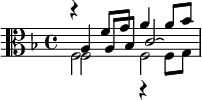 3 variatio 4 variatio  5 variatio  |
[1] | |
| 15v-17r | psalm 116 / J. P. |
 |
Jan Pieterszoon Sweelinck | |
| 16v-17r | O Lux Beata / Trinitas: |
 |
[1] | |
| 17v-18r | psalm 60 / A 2 |
 |
Anonymus: Jan Pieterszoon Sweelinck | |
| 18v-19r | O Gott du / unser Vater / bist / auff 2 Clauiren |
1 variatio 2 variatio 3 variatio  |
Anonymus: Jan Pieterszoon Sweelinck | [1] |
| 19v-21r | P 23 Mein hütter Undt mein hirtt |  |
Anonymus: Jan Pieterszoon Sweelinck | [1] |
| 20v-23r | die 10 Gebott Gottes | 1 variatio 2 variatio  3 variatio  4 variatio  |
Jan Pieterszoon Sweelinck | [1] |
| 23v-25r | Es spricht den / unweisen Mundt / woll |
 |
Heinrich Scheidemann | |
| 24v-25r | Fuga Cromatico / ex D.la.sol.re. |
|||
| 25v-27v | Fantasia / A. 2: 3: et 4 / Vocum |
Anonymus: Jan Pieterszoon Sweelinck | ||
| 27v-28v | Fantasia / Super ut re mi / fa.sol.la. / A. 3. Vocum / pedaliter |
 |
Analysis
After the publishing of 8 more works in Lynar B 2 by Pieter Dirksen in 1991, two works remain unpublished. The Fuga Cromatico and Fantasia Super ut re mi fa.sol.la. were described as "a brief composition employing imitation and simple chromatic lines" and "a pedantic, three-part hexachordal settings, in which the sogetto appears in the bass thirteen times in exactly the same form, constantly alternating between entries on c and G" respectively.
The setting of O God die onse Vader bist can for now be securely attributed to Sweelinck on the basis of the cantus firmus being a Dutch psalm in addition to stylistic features. Similarly, the setting of Psalm 23 can also be attributed to him, especially based on the similarities to Sweelinck's composition on Psalm 116 (which can be found in other manuscripts).
Confusingly, the manuscript contains a piece titled "fantasia primi / Toni A 4" which is neither a fantasia nor in the first tone. In fact, it is a chorale setting of Nun komm, der Heiden Heiland.

It is possible that this heading was written by a different copyist before this work was written at a later date. In any case, this work only uses the first (identical with the last) line of the chorale (which means that this work could be classified as a choral ricercare or choral fugue), and the contrapuntal writing is strikingly plain and schematic. In fact, this piece has been described as containing a "peculiar monothematic compositional technique, which is probably unparalleled in the surviving corpus of seventeenth century choral settings."
According to Pieter Dirksen, the chorale fantasia Ach Gott, vom Himmel sieh' darein stands apart from the other works in Lynar B 2, as it transmits a chorale fantasia in the fully mature form. An attribution to Heinrich Scheidemann is possible. He is the only composer who is known to have composed chorale fantasias before 1650 (actually, this piece was not copied at a later point than the rest of the manuscript, because the same hand can be identified in Lynar B 6 and 7, and the first scribe of the manuscript writes some of the piece). However, this attribution is not secured. Some features which appear in almost all chorale fantasias by Scheidemann such as the simpler 'echo' techniques like monodic right-hand echoes, antiphonal echoes or 'trio echoes', are not found in this work. Also, as shown by Michael Belotti, the practice of showing the Rückpositiv voice in the top line of the manuscript even when it is in the tenor is not found in Scheidemann's music, but it does appear in the Magnificat I. toni by Schildt in the second volume of the Zellerfeld Organ Tablatures[2] (This also occurs in the two chorale fantasias by Hieronymus Praetorius in D-W Cod. Guelf. 8 Noviss. 2/o[3]).
The setting of O Lux beata Trinitas appears to be a result of the early Sweelinck school based on some sixteenth-note figurations that can be found within it. However, it can not be found to be similar to any single composer on stylistic grounds. The cantus firmus appears in the tenor voice completely un-ornamented in long notes. This arrangement suggests that it can be played in pedal, but the voice rises up to f' which would require a 4-foot stop to be used on an organ with a 27-note pedalboard.
References
Beckmann (2009)
Dirksen, P., "Eight Chorale Settings by Jan P. Sweelinck and his School", 1991, Vereniging voor Nederlandse Muziekgeschiedenis, Utrecht
Schierning, 32-34
- ↑ 1.00 1.01 1.02 1.03 1.04 1.05 1.06 1.07 1.08 1.09 Dirksen, P., "Eight Chorale Settings by Jan P. Sweelinck and his School", 1991, Vereniging voor Nederlandse Muziekgeschiedenis, Utrecht
- ↑ DirksenScheidemann 114-115.
- ↑ Beckmann, Klaus (editor), Hieronymus Praetorius: Sämtliche Orgelwerke. Teil 1. Mainz: Schott, 2002.
Lynar B 3
Seiffert: Ms. Lynar B 3 | Deutsche Orgeltabulatur ca. 1630 | Genannt sind darin: H. Scheide- | mann, J. P. Sweelinck, David Abel, | Andr. Düben, M. D., Peter Hasse, | M. W. C. B. M.
Ms. Lynar B 3. German organ tablature from around 1630. Contains: Heinrich Scheidemann, Jan Pieterszoon Sweelinck, David Abel, Andreas Düben, M. D., Peter Hasse, M. W. C. B. M.
D-B Ms. Lynar B 3 Online facsimile: digital.staatsbibliothek-berlin.de accessed 3 November, 2023, mirrored IMSLP554336.
Contents
This manuscript has two sets of foliation which were penciled in at different times: there is a foliation visible at the bottom right of the right-side page, and a foliation which is visible at the top-left of the left-side page. In the table, no.1 refers to both pages which are open when the number is visible on the top left (example: 1v-2r).
| no. | fol. | Title | Incipit | Notes | Ref. |
|---|---|---|---|---|---|
| 1 | 1r | [missing] |  |
Title is on missing verso side | |
| 1 | 1r | Praeludium |  |
Piece continues on missing verso side. | |
| 2 | 1v-2r | Praludium |  |
||
| 3 | 2v-3r | Praludium |  |
||
| 4 | 3v-4r | Praludium |  |
||
| 5 | 4v-5r | Praludium / H S M |
 |
||
| 6 | 5v-6r | Vater unser in Himmell / reich. / MW. C. B. M. |
[1] 2 Variation  3  |
||
| 7-9 | 6v-9r | Fantasia / J. P. |
|||
| 10 | 9v-10r | Fantasia. / 6 toni. |
|||
| 11 | 10v-11r | Praludium / pedaliter |
|||
| 12 | 11v-12r | Herr Christ / der einige Got / tes Sohn. |
|||
| 13 | 12v-12ar | Praludium | "12a" is the folio number inserted between 12 and 13. | ||
| 14 | 12av-13v | Praludium | |||
| 15 | 13v-14r | Praludium | |||
| 16 | 14v-15r | Praludium / secundi Toni / Auf 2 Clavir / und pedale. |
|||
| 17-19 | 15v-18r | Fantasia | |||
| 20-21 | 18v-20r | Vater unser in himmell / reich Corahll / in Bas. |
[1] 2 Vers auf / zwei Clavier / und Pedahll. |
Actually by Heinrich Scheidemann | [Citation needed] |
| 22-23 | 20v-21r | O Mensch Be,, / weine deine / sünde gros auf. / 2 Clavier der Co,, / rahll gecolorirett / M. W. C. B. M. |
|||
| 24 | [23]v-24r | Praeludium / pedaliter / David Abel. |
|||
| 25 | 24v-25r | Praludium / David Abels. |
|||
| 26 | 25v-26r | Fuga | |||
| 27 | 26v-27r | Ricercar / primi Toni |
|||
| 28-30 | 27v-30r | Ricercar / primi Toni / ex G.B.moll |
|||
| 31 | 30v-31r | Praludium / Ex E. Vel/ a. pedaliter / A. D. O. |
|||
| 32 | 31v-32r | Praambulum / pedaliter / M. D. O. |
|||
| 33 | 32v-33r | Praambulum / pedaliter |
|||
| 34 | 33v-34r | Praambulum / pedaliter |
|||
| 35 | 34v-35r | Praambulum / pedaliter / P. H. |
|||
| 36 | 35v-36r | Praludium / pedaliter / M. F. P. S. W. |
|||
| 37 | 36v-37r | Praludium / Pedaliter |
|||
| 38 | 37v-38r | Praludium / M. D. O |
|||
| 39 | 38v-39r | Praludium / pedaliter |
|||
| 39 | 38v-39r | Praludium | |||
| 39 | 38v-39r | Praludium / pedaliter |
|||
| 39 | 38v-39r | Praludium / pedaliter |
|||
| 40 | 39v- | Praludium / pedaliter |
Fragment |
References
- ↑ digital.staatsbibliothek-berlin.de, online scan.
Lynar B 4
Seiffert: Ms. Lynar B 4 | Deutsche Orgeltabulatur ca. 1630. | Genannt nur J. P. Sweelinck, | sonst anonyme Stücke.
Ms. Lynar B 4. German organ tablature from around 1630. Containing pieces by only Jan Pieterszoon Sweelinck, the rest anonymous.
D-B Ms. Lynar B 4 Online facsimile: digital.staatsbibliothek-berlin.de accessed 3 November, 2023.
The page numbers (instead of folios) have been penciled in by a librarian.
Contents
This manuscript contains four pieces:
| Pages | Title | Incipit | Notes | Ref. |
|---|---|---|---|---|
| 1-3 | In dich hab / ich gehoffet / Herr / auf 2 Clavier / Manualiter |
 |
Heinrich Scheidemann | |
| 4-9 | Jesus Christus / unser Heylandt / auf 2 Clavier / pedaliter |
 |
Heinrich Scheidemann | |
| 10-11 | Fantasia / M. J. P. |
 |
Jan Pieterszoon Sweelinck | |
| 14-17 | Fantasia / A 3 Vocum / Transpon: per 4 toni |
 |
Only one piece contains an attribution, the initials M. J. P. (=Jan Pieterszoon Sweelinck). However, all four pieces can be accounted for based on concordances found elsewhere. The first piece appears in D-Lr Mus.ant.pract. K.N. 208/1 titled In dich hab ich gehoffet H.S.M., linking the piece to Heinrich Scheidemann (WV 8[1]). The second piece is also composed by Scheidemann based on concordances in Zellerfeld Organ Tablatures vol.1 and the Pelplin Tablatures (WV 10).[1] The fourth piece is a transposed parody of the Samuel Scheidt Tabulatura Nova, vol. 2 no.6 (the composer of the parody is unknown).
References
Schierning, 31.
Lynar B 5
Seiffert: Ms. Lynar B 5 | Deutsche Orgeltabulatur ca. 1630 | Darin 1 Choralbearbeitung von | Jakob Praetorius (unvollständig)
Ms. Lynar B 5. German organ tablature from around 1630. Contains one choral work from Jacob Praetorius (incomplete).
D-B Ms. Lynar B 5 Online facsimile: digital.staatsbibliothek-berlin.de accessed 3 November, 2023.
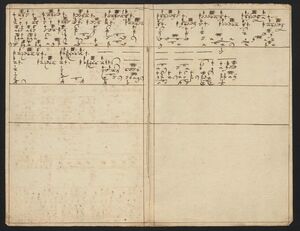
This manuscript contains one piece, a fragment of a Chorale Fantasia Durch Adams Fall ist ganz verderbt auff 3 clavier by Jakob Praetorius.
The piece is neatly written in five voices, suggesting that the top voice is to be played on Rückpositiv, the second on Brustwerk, the third and fourth on Organum, and the bottom in Pedal. It is written in the Echo style; furthermore, this piece provides evidence that Jakob Praetorius was the inventor of the Echo-Choralfantasia on 3 manuals (this style was also written in by Nicolaus Hasse).
References
Beckmann (2009), 151-152.
Brieg, Werner (editor). Jacob Praetorius: Choralbearbeitunen für Orgel. Kassel: Bärenreiter, 1974.
Schierning, 37-38.
Lynar B 6
Seiffert: Ms. Lynar B 6 | Deutsche Orgeltabulatur ca. 1630 | Enthält 1 Toccata von Heinrich | Scheidemann
Ms. Lynar B 6. German organ tablature from around 1630. Contains one toccata by Heinrich Scheidemann.
D-B Ms. Lynar B 6 Online facsimile: digital.staatsbibliothek-berlin.de accessed 3 November, 2023.
Ms. Lynar B 6 contains a manualiter Toccata auf 2 clavir (WV 43) by Heinrich Scheidemann on 10 pages.
An autograph manuscript of this piece has been discovered in D-W Cod. Guelf. 8 Noviss. 2/o. Besides this, copies are also found in many other manuscripts including the first volume of the Zellerfeld Tablatures, D-W Ms. 227, and various different (corrupted) forms in D-Lr Mus.ant.pract. K.N. 208-1 and 209, and D-B Am.B 340 (the last three manuscripts transmit the piece in a "pedaliter version" and are assigned WV number 43a by Dirksen).
Before the discovery of the Wolfenbuttel manuscript, Breig stated that the copy in Ze 1 is likely the most accurate.
References
Breig, Werner. Die Orgelwerke von Heinrich Scheidemann. Beihefte zum Archiv für Musikwissenschaft 3. Wiesbaden: Franz Steiner, 1967. 87-93, 108.
DirksenScheidemann xvii, 3-5.
Lynar B 7
Seiffert: Ms. Lynar B 7 | Deutsche Orgeltabulatur ca. 1640. | Enthält Psalmen und Choräle, alle anonym
Ms. Lynar B 7. German organ tablature from around 1640. Contains psalms and chorales, all anonymous.
D-B Ms. Lynar B 7 Online facsimile: digital.staatsbibliothek-berlin.de accessed 3 November, 2023.
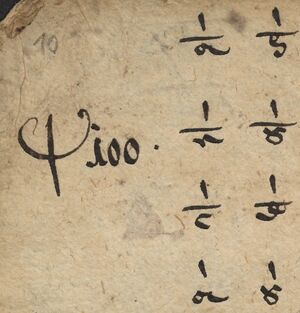
Ms. Lynar B 7 consists of single- and multi-verse settings of various Genevan psalms and the chorale Erhalt uns, Herr, bei deinem Wort.
This manuscript was published by Pieter Dirksen in 1996.
Description
The header of each piece is stylized by a three-pronged symbol followed by the number of the psalm. Some verses are also marked "3 voci" or "Corall in tenor" for example.
Contents
| fol. | Title | Incipit | Notes |
|---|---|---|---|
| 1r-2r | P 66 |  2. V.  |
|
| 2v-3r | P 5 | 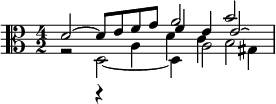 2 Vari / in Basso  3 V. / im Tenor  |
|
| 3v-5r | P 116 |  2 Vari:  3. Vari / Corahll in / Tenor  4 Variatio / a 4  |
|
| 5v-7r | P 100 |  [2 V]  3 variation  [4 V]  |
Written in second hand |
| 6v-7r | Erhalt uns / Herr beij / deinen wortt |
 2 Variation 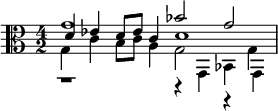 3 Variation 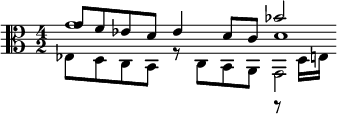 |
Written in second hand |
| 7v-8r | P 24 |  2 V. / a 3  |
Analysis
Dirksen states that the pieces in this manuscript can be conclusively connected with the Netherlands. While such psalm variations (and the psalm melodies themselves) are wholly unknown in Germany, they were abundantly found in the Netherlands, always in variation form (instead of German forms such as the Chorale Fantasia).
According to Dirksen, the five psalm melodies found in Ms. Lynar B 7 were the most popular melodies from the Genevan Psalter during this time period.
The psalm variations are marked by a great unity of style. On the other hand, the setting of Erhalt uns, Herr, bei deinem Wort is found to be slightly more sophisticated, and it has more rhythmic and harmonic variety. The compositions share a number of recurring musical patterns with pieces by Jan Pieterszoon Sweelinck, but the pieces are too conservative in character to have been composed by him. They were likely written by another composer who lived around the same time. They were probably brought to the German-speaking lands by a student of Sweelinck who copied them into tablature notation.
References
Dirksen, Pieter (editor). Psalm Variations from Lynar B 7. Exempla Musica Neerlandica XVIII. Utrecht: Koninklijke Vereniging voor Nederlandse Muziekgeschiedenis, 1996.
Lynar B 8
Seiffert: Ms. Lynar B 8 | Deutsche Orgeltabulatur ca. 1630. | darin der Siefertschüler Andreas | Neunaber vertreten
Ms. Lynar B 8. German organ tablature from around 1630, containing Andreas Neunhaber, the student of Siefert.
D-B Ms. Lynar B 8 Online facsimile: digital.staatsbibliothek-berlin.de accessed 3 November, 2023.

This manuscript contains two pieces, "Ich ruff zu / dir herr / Jesu Christ / auff 2. clavier" and "Alio modo / auff 2. und 3. / Clavir, und auff der / Pedal zu gebrauch: / Anton Neunhaber." These are thought to be two verses of the same piece by Andreas Neunhaber (Max Seiffert made the connection from Anton -> Andreas Neunhaber).
Description
Unlike all of the other Lynar B tablatures, this manuscript splits the octave at 'h' instead of 'c'.
Lydia Schierning said that Neunhaber was only the composer of the second piece and that it is possible the scribe was planning to create a larger compilation of chorale settings on this chorale tune by different composers. On the other hand, Klaus Beckmann said that these are two verses of one piece by Neunhaber.[1]
The second piece is in five voices and has detailed manual change indications written into the tablature.[2]
Contents


References
Schierning, 39.
- ↑ Beckmann (2009), 397.
- ↑ Beckmann, K. (editor). 3 Choralbearbeitunten von Anton Neunhaber und Ewald Hintz. Wiesbaden: Breitkopf & Härtel, 1974.
Lynar B 9
Seiffert: Ms. Lynar B 9 | Deutsche Orgeltabulatur ca. 1630 | 2 anonyme Praeludien.
Ms. Lynar B 9. German organ tablature from around 1630. Two anonymous preludes.
D-B Ms. Lynar B 9 Online facsimile: digital.staatsbibliothek-berlin.de accessed 3 November, 2023.
Lynar B 9 contains two preludes on two pages. The title page lists the keys/tonality "A cis" and "F a".
Both preludes were edited by Partitura Organum in 2019.
Description
Both preludes are typical of the north-German präludium.
Some notes are not visible on the edge of the left page.
Contents



Scores
Prelude 1: partitura.org, 31 October, 2019. (Score) Accessed 14 January, 2023.
Prelude 2: partitura.org, 5 November, 2019. (Score) Accessed 14 January, 2023.
References
Schierning, 39.
Lynar B 10
Seiffert: Ms. Lynar B 10 | Deutsche Orgeltabulatur ca. 1640. | Inhalt 1 anonyme Choralbearbeitung
Ms. Lynar B 10. German organ tablature from around 1640. Contains one anonymous choral work.
D-B Ms. Lynar B 10 Online facsimile: digital.staatsbibliothek-berlin.de accessed 3 November, 2023.
This manuscript contains one piece, anonymous Sei nun wieder zufrieden a 3. The composition ends after the first system on the third page, the final symbol is a cut time signature.
The texture of the piece is very odd compared to all the other pieces contained in the Lynar Tablatures.
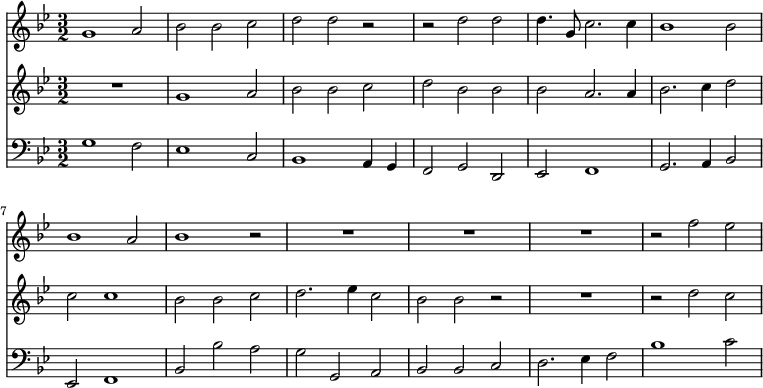
Actually, it appears that it is an intabulation of a cantata instead of an original organ piece (Scierning says that it seems to have been written for two sopranos and basso continuo).
The title is from Psalm 116, verse 7.
References
Schierning, 106
Lynar C 1
Title label, mid-20th century: Ms. Lynar C 1 Melodien zum 1. bis 150. Psalm
Ms. Lynar C 1: Melodies of Psalms 1-150.
Lynar C 1 (also called C or B 11[Citation needed])contains anonymous 4-voice settings of the 150 genevan psalms (actually only 124 settings, because of the reuse of psalm tunes). It is written on 119 sheets in New German Tablature Notation.
The settings are extremely simple. It appears that this was a psalm-book that used privately by people gathered together, who would sing the psalms, or play them on all different instruments, at social gatherings (or it was a copy of this type of book).
References
Schierning, 106-109.